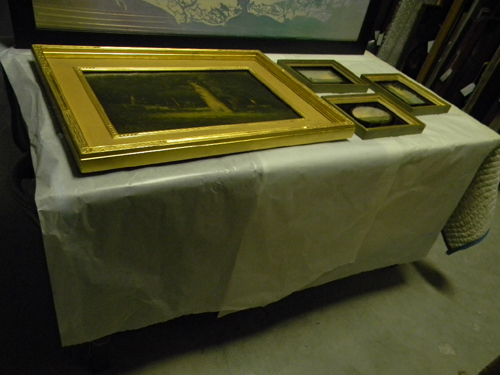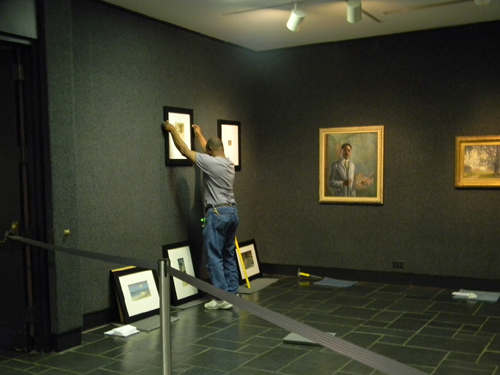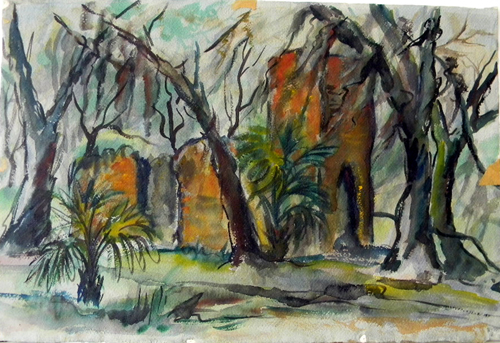Untitled, ca. 1940s-50s, by Nell Choate Shute (American, 1898–1966), 2010.005.0002B
Have you visited the Gibbes lately? If so, you may notice new faces in the building. Yes, we do have a few new staff members, but I am referring to the new paintings and works on paper on display in The Charleston Story. Ok, they are not really new in the sense that they were just created—although a few of the works are new acquisitions—but many of these pieces have been in storage for a while so they are new to our visitors. Confused yet?
Let’s start over. Each January and July we rotate objects on display in The Charleston Story, a fabulous exhibition that showcases the range and depth of the Gibbes permanent collection. The Charleston Story is installed in nine different galleries throughout the museum and currently includes over 150 works of art. However, this is only a small fraction of the Gibbes permanent collection which contains over 1500 paintings and miniature portraits and 4000 works of art on paper! Objects are rotated in and out of the ongoing exhibition so we can share as many works as possible with our visitors. Object changes also serve a conservation purpose. Over time, all objects can change or deteriorate as a result of environmental conditions. The major environmental factors that affect the long-term preservation of objects are light, relative humidity, and temperature. Works on paper are especially susceptible to light so we store them in cool, dark containers after six months on display. How an object is handled, displayed, and stored can mean the difference between preserving it for many years or for only a short time.
Rotating objects in The Charleston Story is a group effort and requires months of pre-planning. Sara Arnold, our Curator of Collections, chooses the objects for the exhibition. She must consider how a particular piece will fit the theme of each section as well as how it will fit visually with other works in the gallery. Sara also researches each object and writes descriptions about the artist or subject matter—no small task! Once Sara selects the objects for the rotation, I enter the picture. As Director of Collections Administration, one of my responsibilities is to oversee the movement of artwork within the building. I identify an object’s storage location, remove the object from storage, and assess its overall condition. Greg Jenkins, the museum’s preparator, then completes any matting and framing required for exhibition.

Objects are pulled from storage and prepared for installation.
After works are chosen, conditioned, and prepared for view, we set an installation schedule. Changing out The Charleston Story can be logistically complicated due to the fact that it spans multiple galleries. For the safety of the objects, we try to complete most art installation on Mondays when the museum is closed to the public. However, try as we might, reinstallation of galleries almost always takes longer than a day, and sometimes a week! The process of hanging art work is interesting (lots of math) but not always pretty (think hammers, drills, tape measures, tool carts, and labels). If you visit the Gibbes in January or July you may see art moving around the building or encounter a roped off gallery where we are working diligently to finish the switch. We love an audience and encourage questions from our visitors.
On installation days, Greg and I first remove works from exhibit and return them safely to storage. Next, the remaining works are taken down in preparation for a new arrangement. When the gallery walls are clear, the new additions are brought into the space. We position them around the room on carpet squares or a set of “bumpers,” which are special carpeted planks that protect ornate frames. At this point, Sara is back on the scene to determine how best to arrange the pieces within the gallery, and Greg begins to install. Once the art is on the wall, he hangs the labels, removes his tools, resets the lights, and… voila, The “new” Charleston Story. The final step includes checking the condition of works removed from exhibition and updating the object locations in our collections database.

Preparator Greg Jenkins reinstalling a wall in Gallery G.
So there you have it—another behind-the-scenes look at what your friendly museum staff does with their time. Come see what’s new—I’m off to the next project!
—Zinnia Willits, Director of Collections Administration, Gibbes Museum of Art
Tour highlights of the Gibbes’ collection with one of our interactive online features.
Published August 12, 2010


